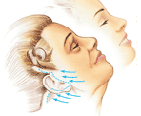What do you think when you look in the mirror? Do you see that your face and neck is changing, that your skin does not look young and creases become deeper? Due to environmental factors, the aging process, genetics and other factors a person’s skin loses elasticity and, hence, creases and lines develop. The skin becomes droopy and furrowed, making a person look older. Due to modern plastic surgery methods it is now possible to turn the hands of time and look younger than you are. However, many patients avoid having surgical procedures due to possible risks associated with them.
Threadlift
Threadlift facelift is a modern cosmetic technique that aids in rejuvenation of the face without surgical intervention. Threadlift is a new cosmetic rejuvenation procedure used to lift drooping brows, jaws and cheeks. Certain filaments help to hold the surrounding tissues, so they are not sagging anymore. No visible scars are created.
This procedure involve minimal invasion. A doctor has to make a small, almost invisible notch into which Threadlift filaments are inserted. They then hold up the surrounding tissues by being fixated into the area. The notch is usually located at the hairline or behind the ear. These specific filaments enhance your body to produce new collagen bundles, which improve condition of the skin.
Different areas can be exposed to this cosmetic procedure . Your doctor will decide individually which areas can be treated in your case to achieve the best effects and goals. Most usually Threadlift rejuvenation procedure is used to lift droopy brows, shift floppy cheeks and improve neck and jowl areas.
This cosmetic procedure is done under local anesthesia with light sedation if needed. It is performed at the doctor’s office or outpatient facility, and you will not have to stay overnight after rejuvenation. Duration of Threadlift depends on the extent of the procedure and the amount of filaments used. Usually the procedure should take up to one hour. You should be able to leave the doctor’s office right away.
Threadlift recovery
You should be aware that even though recovery after Threadlift is shorter compared to major surgery, it still takes some time until last results are visible. Swelling and bruising is visible straight after the procedure. You will have to apply ice compresses for a day or two to minimize swelling and discomfort. Your doctor will instruct you exactly on how to behave after Threadlift rejuvenation. In general, you should avoid strenuous exercise and activities for a month after the procedure. You should be able to return to your work within a week.
Usually patients do not need more than one procedure to achieve best results. If additional Threadlift rejuvenation is needed, it can be performed within a month after the first one. This procedure can be done in conjunction with other cosmetic procedures, such as Botox or collagen injections. This improves final results of one cosmetic procedure and prolongs the lasting effects. Besides, if a patient decides to benefit from major facial cosmetic surgery, such as browlift, facelift and other, in the future he/she is able to do so at any time.
Threadlift advantages
Threadlift offers a lot of advantages. It is a minor procedure that takes a short time to perform. Unlike major plastic surgery , it is minimally invasive but provides long-lasting results without scarring, anesthesia associated risks, a long healing period and hospital treatment. Another advantage is that Threadlift rejuvenation procedure is cheaper that facelift . It also does not provide dramatic changes to your facial appearance and, therefore, you will not gain a stretched, artificial look.
Usually Threadlift cosmetic procedures are chosen by people who have minimal sagging effects due to aging and are in the age range of 40 to 60. Their facial and neck skin is furrowed and sagging but they do not want to undergo major plastic surgery. On other side, they want to achieve better and longer effects than that gained due to Botox injections or collagen filament injections.
Threadlift risks and side-effects
The duration of the effects depends on many factors, such as the extent of sagging, patient’s age, method used, and areas treated etc. Your skin will continue aging and this is very individual. In most cases, may be visible between two to four years. Additional procedures may be required to slow down the aging process.
Risks and complications are rare but still possible and, therefore, you should be aware of them before deciding to undergo Threadlift. The incidence of complications depends mostly upon the skills of the doctor. Possible side effects are infection, swelling, tenderness or numbness, slight asymmetry and other minor changes. Complications or side effects are only short lasting and disappear later if the procedure is performed by a skilled professional. Besides, Threadlift is totally convertible if needed for up to one month after its performance.
Threadlift is an FDA approved technology and is safe. Only doctors, who undergo extensive training, are able to perform this procedure.
The cost of the cosmetic intervention depends on amount of filaments used during Threadlift . An average cost of Threadlift procedure, during which brows, cheeks and neck area is enhanced, is from $3,500 to $5,000.
 Facelift is a surgical procedure, professionally known as rhytidectomy, during which excess fat is removed, facial muscles are tightened and facial skin is redraped. As a result of this surgery people can see improved signs of the aging process, they are no longer visible. In addition, facelift may be performed in combination with other
Facelift is a surgical procedure, professionally known as rhytidectomy, during which excess fat is removed, facial muscles are tightened and facial skin is redraped. As a result of this surgery people can see improved signs of the aging process, they are no longer visible. In addition, facelift may be performed in combination with other  A mini facelift is a
A mini facelift is a  Also, the skin of the face may feel numb and it is quite usual after the procedure. This feeling should fade away in a several weeks or months.
Also, the skin of the face may feel numb and it is quite usual after the procedure. This feeling should fade away in a several weeks or months. There are a lot of beauty products that can help you regain youthful looks with
There are a lot of beauty products that can help you regain youthful looks with